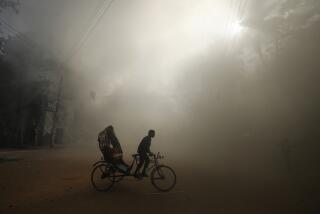Thai troops fire on ‘Red Shirt’ protesters in Bangkok
- Share via
Reporting from Bangkok, Thailand, and New Delhi — Thai troops on Friday opened fire on anti-government protesters in a bid to clear the streets and end a two-month siege, leaving eight people dead and more than 100 wounded and turning parts of Bangkok’s vibrant business district into a virtual war zone.
In a country that markets itself to tourists as the “Land of Smiles,” the images from the capital were becoming surreal. Thousands of soldiers descended on the city center. Troops in camouflage took cover near five-star hotels in road medians decorated with flowers.
Several grenades hit a shopping center and an elevated train station. Bangkok’s sky train was halted, and embassies and downtown businesses were shuttered. Gunshots and explosions reverberated through largely deserted streets a few blocks from the intersection commandeered by “Red Shirt” protesters.
Although the focus of the standoff is a few square blocks of prime real estate, the roots go much deeper.
On one side are the protesters who have adopted red as their color. They draw support from farmers, the poor and the working class. They contend that the government is out of touch with the people, and they demand new elections and the resignation and deportation of Prime Minister Abhisit Vejjajiva.
On the other side are the middle and upper classes, the military, business tycoons and those close to the monarchy, who stress the importance of law and order and contend that a few thousand disgruntled people should not be allowed to hold the nation hostage.
Bangkok faced the prospect of a potentially brutal crackdown or a further descent into chaos. The betting is on a crackdown amid signs the government is running out of patience.
“The protesters are going to move out, either voluntarily or by force,” said David Tuck, Bangkok-based research director with Spectrum OSO Asia, a risk analysis firm, “with force increasingly the preferred option.”
Even if the government succeeds in dislodging the 10,000 or so protesters camped out in Bangkok, it has its work cut out for it. Thailand’s nonconfrontational culture and deep respect for King Bhumibol Adulyadej, 82, has helped delay what some see as overdue structural reforms needed to tackle corruption, inequality and social injustice.
Last week, there was some hope of an easing of the crisis after the Abhisit government offered to hold elections in November.
But leaders of the protest movement promptly upped their demands. Then on Thursday, the shooting of a rogue army general and military advisor to the Red Shirts, Maj. Gen. Khattiya Sawasdipol, angered many in the protest camp. Khattiya remained in a coma Friday.
The government, meanwhile, has been tightening its grip. Power was cut to the upscale commercial area where the Red Shirts are encamped. And late Thursday, the army tried to surround the protesters, who include women and children.
Some analysts said that effort had fallen short. Troops found themselves under attack from behind by protesters who were not with the main group.
“It seems it’s a siege, plus a bunch of small disparate protests,” said Michael Montesano, a Southeast Asia studies professor at the National University of Singapore. “The real problem is that you’re dealing with a divided Red Shirt movement.”
The imposition of emergency law in 17 of Thailand’s 76 provinces Thursday suggests the government is worried that discontent will spread, Montesano said.
Both sides are feeling the wear and tear of the two-month standoff. Increasingly, Red Shirt leaders are finding it difficult to keep rank-and-file members focused as “mission fatigue” sets in, Tuck said. The government’s effort to hew to a middle course between accommodation and confrontation has left it open to criticism that it’s weak and ineffective.
The clash has also taken a huge toll on Thailand’s economy, tourism industry and international reputation. Kittipak Zaphu, owner of Bangkok’s S.V. Tour & Travel, said foreign tourists have been canceling in droves, cutting his business in half.
Many Bangkok residents who initially supported the protesters are also exhausted, tired of the canceled trains, packed busses and inability to hold business meetings.
“This has been going on so long. Hopefully it ends soon,” Kittipak said with a sigh. “I just want the country to be better, and things can return to normal.”
Tourism officials contend that the images beamed around the world give a wrong impression that the whole country is under siege, when in fact only a small part of the capital is affected.
“My friends and family back home are worried,” said Rhys Parry, 30, a tourist from Switzerland enjoying a dinner of cashew chicken and tom yum soup. “They only see the news. They don’t see that 80% of the city is fine.”
But that’s not likely to reassure risk-averse tourists looking for an idyllic beach vacation, and it could take years for Thailand to burnish its international reputation.
More to Read
Sign up for Essential California
The most important California stories and recommendations in your inbox every morning.
You may occasionally receive promotional content from the Los Angeles Times.








